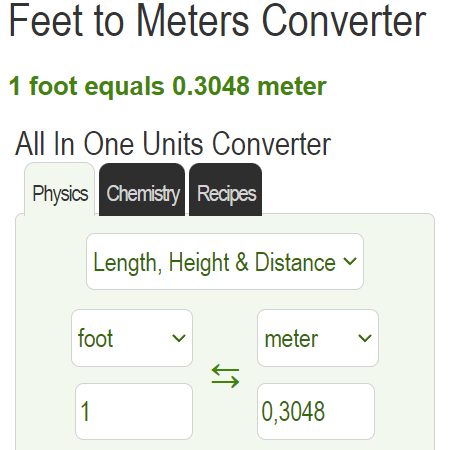1 m to angstroms
1 m is equal to 1 × 1010 angstroms
m To Angstrom Converter
| ⇆ | ||
|
|
||
|
🔗 Help our site grow by sharing it!
|
||
To find the value in meter that corresponds to a value in angstroms, multiply the value in m by 1 × 1010 (the conversion factor). Here is the Conversion formula
Value in angstroms = value in m × 1 × 1010
Let's say that you have 1 m and you want to convert it to angstroms. By using the conversion formula provided above, you get:
Value in angstrom = 1 × 1 × 1010 = 1 × 1010 angstroms
This conversion formula works because one angstrom is equal to 1 × 10-10 m.
To convert a different value in m, simply replace the value in the formula above with the new value.
What is the Relationship Between M and Angstroms
The Exact Relationship is Defined as follows:
1 angstrom = 1 × 10-10 m
This means that to convert a measurement from m to angstroms, you multiply the value in m by 1 × 10-10.
Using The Calculator
Here is how to switch from m to angstroms:
- Determine the measurement in m that you are working with: For this example, let's use
1 m. - Apply the formula: Multiply the value in m by 1 × 1010:
Value in angstroms = 1 × 1 × 1010 - Perform the calculation: Youmay use want to use a calculator or do the math:
Value in angstroms = 1 × 1010 angstroms
Quick Tips For Mental Math
If you don't have a calculator handy, or you want to do a quick mental estimate, you can approximate:
- Use 1 × 1010 instead of 1 × 1010 for a rough estimate.
- For example:
- 1 m ≈ 1 × 1010 angstroms, (1 × 1010, exactly)
- 2 m ≈ 2 × 1010 angstroms, (2 × 1010, exactly)
- 3 m ≈ 3 × 1010 angstroms, (3 × 1010, exactly)
Conclusion
You've learned how to convert m to angstroms and vice versa! Use the formula angstroms = m ÷ 1 × 10-10 for accurate results, or approximate using quick mental math for a rough estimate.
Common Questions This Converter Can Answer
Basic Conversions
- How many m are in 1 angstroms?
- 1 m is equal to how many angstroms?
- What is 1 m in angstroms?
Conversion Methods
- How do I convert from m to angstroms?
- What is the conversion factor between m and angstroms?
- What formula should I use to convert m to angstroms?
Practical Applications
- How do I measure m in angstroms?
- What's the equivalent of 1 m when expressed in angstroms?
- How can I convert between m and angstroms for my project?
Common Conversions
- What is 1 m in angstroms?
- How much is 10 m in angstroms?
- What's half a m in angstroms?
Professional Use
- How do I convert m to angstroms in technical documentation?
- What's the precise conversion rate from m to angstroms?
- How do international standards convert between m and angstroms?
Definition of Meter
A meter (m) is the fundamental unit of length in the International System of Units (SI). It is defined by taking the fixed numerical value of the speed of light in vacuum (c) to be 299,792,458 when expressed in the unit m/s. This modern definition, established in 1983, ensures that the meter is standardized through universal physical constants. The meter is used worldwide in science, industry, and everyday measurements. In practical terms, a meter is slightly longer than a yard, being approximately 39.37 inches. This unit is essential in construction, engineering, athletics, and countless other applications. The meter's subdivisions (centimeters, millimeters) and multiples (kilometers) form the basis of the metric system used globally.
Definition of Angstrom
An angstrom (Å) is an extremely small unit of length equal to one ten-billionth (10⁻¹⁰) of a meter. This unit is primarily used in:
- Atomic and Molecular Science:
- Measuring atomic radii
- Crystal lattice spacing
- Chemical bond lengths
- Spectroscopy:
- Light wavelength measurements
- X-ray diffraction analysis
- Electromagnetic spectrum studies
- Nanotechnology:
- Molecular structure analysis
- Thin film measurements
- Quantum dot specifications



